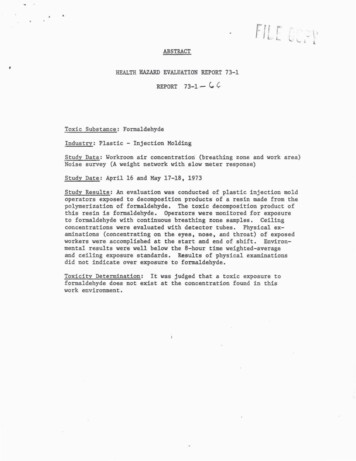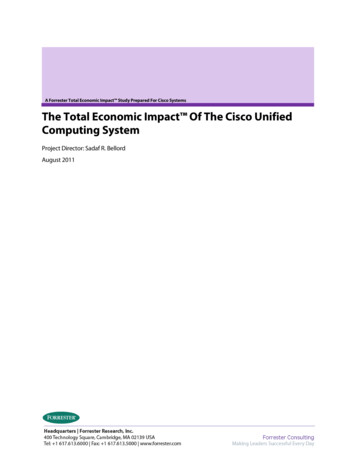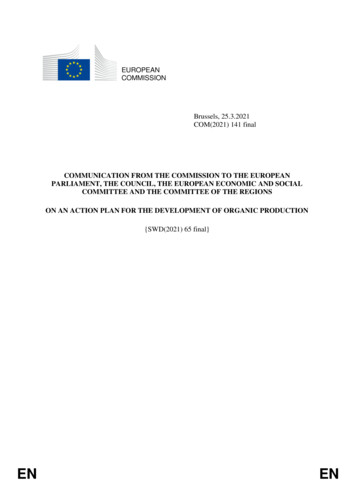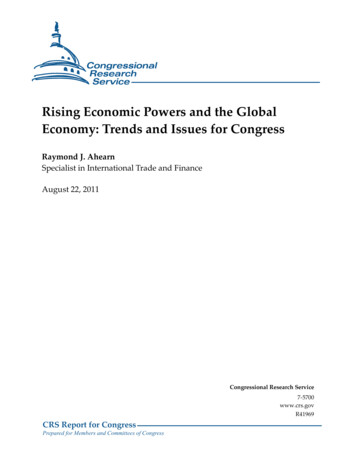
Transcription
Clarke et al. Systematic Reviews(2019) OCOLOpen AccessHealth economic evaluation in orthoticsand prosthetics: a systematic reviewprotocolLeigh Clarke1,2* , Michael Dillon1 and Alan Shiell3AbstractBackground: Health economic evaluations are essential to support health care policy and investment decisions. To date,health economic evaluations in orthotics and prosthetics have focused on discrete components of an orthosis/prosthesis(e.g. a microprocessor controlled prosthetic knee joint) rather than the broader service provided by orthotist/prosthetists. Assuch, the contribution to orthotic/prosthetic policy and investment decisions is unclear. Whilst there are opportunities toconduct more informative health economic evaluations that describe the costs and benefits of the orthotic/prostheticservice, it is important that prospective research is informed by a critical review of the method design challenges and anunderstanding of how this research can be improved. The aim of this systematic review is to critically appraise the existingorthotic/prosthetic health economic evaluation literature and therefore determine evidence gaps, critical method designissues and the extent to which the literature informs orthotic/prosthetic policy and investment decisions.Methods: A comprehensive range of databases—AMED, EMBASE, MEDLINE and PsychINFO, Cumulative Index of Nursingand Allied Health Literature (CINAHL), ProQuest Nursing and Allied Health, Web of Science, Cochrane Database of SystematicReviews (CDSR) and specialty health economic databases—will be searched using National Library of Medicine MedicalSubject Headings (MeSH) terms as well as the title, abstract, and keyword terms. Search terms related to the intervention(e.g. orthosis), including variants used by varying professional disciplines (e.g. brace), will be used in preference to definingthe populations that use orthotic and prosthetic services (e.g. people living with rheumatoid arthritis). Search terms relatedto health economic evaluations will be guided by previously developed and tested search strings and align withrecommendations by the Canadian Agency for Drugs and Technologies in Health. Articles meeting the inclusion criteria willbe hand-searched for relevant citations, and a forward citation search using Google Scholar will also be conducted toidentify early online articles not yet indexed in traditional databases. Original research published in the English language andafter 1 January 2000 will be included. The Checklist for Health Economic Evaluation Reporting Standards (CHEERS) and theConsensus on Health Economic Criteria (CHEC)-Extended list will be used to appraise the methodological quality andidentify sources of bias. Data extraction and appraisal will be conducted by one reviewer independently using appraisalinstrument guidelines and a content specific decision aid with exemplars. A subsequent review by a second researcher willbe undertaken to confirm the accuracy of the extraction and appraisal, and a final review by a third where consensuscannot be reached. The data will be extracted to a purpose-built data extraction template with decision-making guidelinesto support consistency. Where possible, the findings of the review will be reported as a meta-analysis, although theheterogeneity of the literature will likely mean a narrative review that illuminates method design issues that contribute toimprecision and variation will be more appropriate.(Continued on next page)* Correspondence: leigh.clarke@aopa.org.au1Discipline of Prosthetics and Orthotics, Department of Physiotherapy,Podiatry, Prosthetics and Orthotics, School of Allied Health, Human Servicesand Sport, La Trobe University, Melbourne, Victoria 3083, Australia2The Australian Orthotic Prosthetic Association Ltd, Melbourne, Victoria 3124,AustraliaFull list of author information is available at the end of the article The Author(s). 2019 Open Access This article is distributed under the terms of the Creative Commons Attribution 4.0International License (http://creativecommons.org/licenses/by/4.0/), which permits unrestricted use, distribution, andreproduction in any medium, provided you give appropriate credit to the original author(s) and the source, provide a link tothe Creative Commons license, and indicate if changes were made. The Creative Commons Public Domain Dedication o/1.0/) applies to the data made available in this article, unless otherwise stated.
Clarke et al. Systematic Reviews(2019) 8:152Page 2 of 8(Continued from previous page)Discussion: This protocol has been purposefully designed to summarise the existing evidence and appraise themethodological approaches used and the quality of the health economic evaluations in orthotics and prosthetics.What we learn from this review will be used to guide further work in this area and design more rigorous healtheconomic evaluations into the future.Systematic review registration: PROSPERO CRD42018116910.Keywords: Systematic review, Economic evaluation, Health economics, Cost-effectiveness, Cost-benefit, Orthotics,ProstheticsBackgroundPeople with mobility-related impairments, such as stroke,cerebral palsy or amputation, use orthoses/prostheses toassist with function, activity and participation [1].Historically, orthoses/prostheses were provided byhighly skilled tradespeople with little responsibility beyond the manufacture and supply of the orthosis/prosthesis [2–4], and as such, there was significant medicaloversight for the associated clinical role which includedprescription and reviews [2].Over time, the role of the orthotist/prosthetist has become increasingly clinical [2, 5] as education and training have shifted from an apprenticeship model totertiary education that emphasised the clinical role necessary for autonomous professional practice [3]. Assuch, many aspects of the clinical role that were onceprovided by medical specialists are now the responsibility of the orthotist/prosthetist including prescription, reviews and education, as illustrative examples [3, 5].Into the future, the clinical role of the orthotist/prosthetistwill continue to evolve with the introduction of new, contemporary models of care that focus on supporting clients toidentify the goals of their treatment [6] and measure howsuccessfully these goals have been achieved. By way of example, the Australian National Disability Insurance Scheme,a national funding model for disability services and interventions, has been designed to redress the historical, paternalistic prescribing role of practitioners [7]. Instead, practitionersare expected to use high-level communication skills to facilitate discussions, thereby supporting clients to identify theirown treatment goals [6, 8] and inform their decision aboutorthotic/prosthetic interventions given an understanding ofthe likely outcomes [7, 9]. Practitioners are also expected toevaluate the effectiveness of an intervention using valid andreliable outcome measures [10, 11] and, in this way, demonstrate the contribution that the intervention makes towardsthe attainment of a client’s goals.The enhanced clinical role of the orthotist/prosthetist andthe introduction of more contemporary models of care havefundamentally changed the way orthotic/prosthetic clinicalservices are provided. However, the small pool of orthotic/prosthetic health economic evaluation literature has remainedfocussed on evaluating the cost-effectiveness of newer, high-cost technologies (e.g. microprocessor prosthetic knees orbone-anchored prostheses) compared to the current standardtechnologies [12–17]. Whilst these studies make a meaningfulcontribution to technology-related policy decisions, they donot inform decisions regarding the funding of comprehensiveclinical services provided by orthotist/prosthetists that focuson supporting clients to achieve their goals of which theprovision of technology is a component.A prudent first step to developing a contemporary approach to orthotic and prosthetic health economic evaluations would be to conduct a systematic review of the currentorthotic/prosthetic literature. Critical appraisal of the available health economic evaluation research would identify evidence gaps and critical method design issues that couldinform an assessment of the extent to which current literature can meaningfully contribute to decisions about fundingof contemporary clinical services of which provision of anorthosis/prosthesis is part. The outcomes of the systematicreview could also inform the design of more rigorous healtheconomic evaluations into the future.In summary, health economic evaluations are essential tosupport health care policy and investment decisions. Todate, health economic evaluations in orthotics and prosthetics have focused on discrete components of an orthosis/prosthesis (e.g. a microprocessor-controlled prostheticknee joint), and whilst these studies can help informtechnology-related policy decisions, they are unlikely to bewell-designed to inform decisions about contemporary clinical services in which technologies, such as prostheses andorthoses, are provided. Therefore, it is unclear whethercurrent evaluations adequately contribute to costeffectiveness knowledge, policy and investment decisionsfor orthotic/prosthetic services. Into the future, there areopportunities to conduct health economic evaluationswhere the costs and benefits of the orthotic/prosthetic service are measured in contemporary healthcare models, suchas the National Disability Insurance Scheme, thereforeinforming health care policy and investment decisions forpeople requiring orthoses/prostheses within such schemes.A prudent first step would be to conduct a systematic review of the current orthotic/prosthetic health economic literature to identify evidence gaps, and method design issuesthat can inform the design of rigorous health economic
Clarke et al. Systematic Reviews(2019) 8:152evaluations focused on the cost-effectiveness of contemporary services of which the provision of a prosthesis/orthosisis part.The aim of this systematic review is to critically appraise the existing orthotic/prosthetic health economicevaluation literature and therefore determine evidencegaps, critical method design issues and the extent towhich the literature informs orthotic/prosthetic policyand investment decisions.MethodSearch strategyThe OVID platform will be used to search the followingdatabases independently: AMED, EMBASE, MEDLINEand PsychINFO. Separate searches will also be conductedfor Cumulative Index of Nursing and Allied Health Literature (CINAHL), ProQuest Nursing and Allied Health, Webof Science and the Cochrane Database of Systematic Reviews(CDSR). In line with recent search strategy recommendations, core database searches will be complemented withhealth economic specific database searches including Centrefor Reviews and Dissemination (CRD) Health TechnologyAssessment and the National Health Service EconomicEvaluation Database (NHS EED) [18–21].National Library of Medicine Medical Subject Headings (MeSH) will be used for the relevant aforementioned databases, including the terms for ArtificialLimbs, Amputation, Amputees, Orthotic Device, Costbenefit Analysis, Costs and Cost Analyses and Qualityadjusted Life Years. These MeSH terms include all relevant root and hierarchical branches related to the intervention (i.e. prostheses and orthoses) and outcome (e.g.health economic evaluation, cost-effectiveness) and willalso be exploded to reduce the likelihood that relevantpublications will be overlooked due to variations in theway articles are indexed.Search terms related to the intervention (i.e. prosthesesand orthoses), as well as variants used by varying professional disciplines (e.g. splint, brace), will be used in preference to defining the populations that use orthotic andprosthetic services which are very broad (e.g. cerebralpalsy, stroke, scoliosis, rheumatoid arthritis, plagiocephaly). Search terms related to health economic evaluations (e.g. cost-effectiveness, cost-utility) will be based onpreviously developed and tested search strings [22, 23]and align with recommendations by the CanadianAgency for Drugs and Technologies in Health [20].Synonyms and acronyms for each of the aforementionedsearch terms will be used in combination with Booleanoperators and wild cards to ensure variations in spellingand punctuation (e.g. cost effectiveness and cost-effectiveness) are captured. Search terms and larger search stringswill be developed, tested and modified based on the searchresults from each database that highlight terms in the titlePage 3 of 8(ti), abstract (ab) and keyword (kw) that were relevant.Where these field codes vary across databases, the appropriate alternative will be used.Search terms designed to exclude irrelevant literaturewill also be used given a large body of research relatingto internal or dental prostheses (e.g. hip or dental implants). In this way, studies pertaining to internal hipand knee replacements and other non-limb prostheticresults (e.g. aortic, valve, breast) will be excluded. It isknown that dental literature uses numerous terms (e.g.overdentures, implant-supported, or restoration) that arealso non-dental specific (e.g. implant) therefore preventing efficient exclusion using single search terms and willinadvertently exclude relevant prosthetic literature (e.g.osseointegration studies in which the term implant isused). Therefore, instead of using search terms to exclude irrelevant dental literature, a MeSH search strategywill be used (i.e. Exp Dentistry/), allowing exclusion ofall studies indexed under this subject heading, includingall root and hierarchical branches.The aforementioned MeSH and search terms were developed through an analysis of the keywords, titles and abstractsof known relevant journal articles. As part of protocol development,
and prosthetics: a systematic review protocol Leigh Clarke1,2*, Michael Dillon1 and Alan Shiell3 Abstract Background: Health economic evaluations are essential to support health care policy and investment decisions. To date, health economic evaluations in orthotics and prosthetics have focused on discrete component s of an orthosis/prosthesis (e.g. a microprocessor controlled prostheti c knee .











